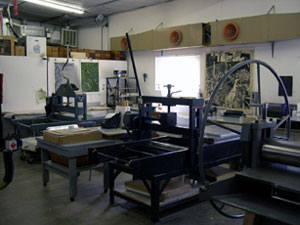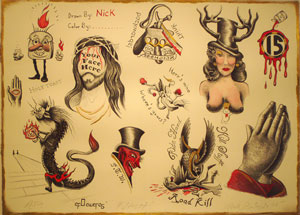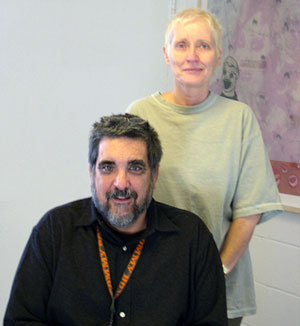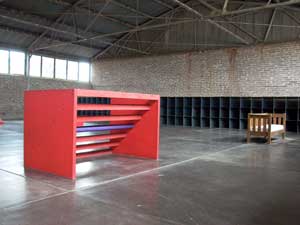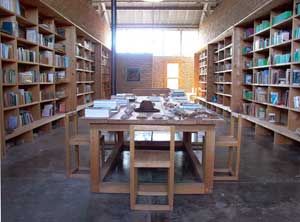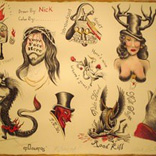This year’s Chinati Foundation Open House was its eleventh since Donald Judd’s
death in 1994, but you still felt like no one would bat an eye if Judd
walked in, pulled up a chair, and sat down for a round of tequila shots.
This year’s Chinati Foundation Open House was its eleventh since Donald Judd’s death in 1994, but you still felt like no one would bat an eye if Judd walked in, pulled up a chair, and sat down for a round of tequila shots. And if Judd did come back to his old haunts, it would seem he wouldn’t find much amiss: there are dishes in the kitchens, sheets on all of the beds, even Judd’s favorite bedtime reading on the nightstand at one of his ranches outside of town.
This commitment to preservation can be somewhat eerie. Judd’s library hasn’t been touched since his death. Each volume remains on the shelf as it was a decade ago: the books on artists organized by birth date, science books separate from art history, fiction kicking around in there somewhere. Magazine articles from the mid-1980s on Judd’s primary residence in Marfa, known as Mansana de Chinati or “the Block,” feature photographs that exactly match what’s still there twenty years later. It’s a wonder we don’t have Judd’s trash boxed up in a warehouse somewhere in Marfa, its contents waiting to be dutifully recorded, like Andy Warhol’s Factory-detritus-filled time capsules, which Warhol Museum staff are still cataloging.
Yet the comforts of home are ostensibly not the Block’s main attraction. In addition to the dishes and books, Judd’s former residence features an impressive collection of his sculptures, which the artist installed himself and intended for permanent display. In order to preserve this arrangement, the Judd Foundation was established in 1996 (through the artist’s will) to preserve his living spaces in New York and Texas. Judd’s ideas about the display of artworks, and his home’s concomitant preservation, places the Block somewhere between a shrine (a la Graceland), an historic home (a la the White House), and a museum. I’m not sure about the White House or Graceland, but the third option was definitely not what Judd had in mind.
Judd bought his first buildings in Marfa in 1973. According to the artist, he was eager to leave New York “due in part to the harsh and glib situation within art in New York and to the unpleasantness of the city.” The shipment of a large sculpture from a 1971 exhibition of his work at the Pasadena Art Museum set the deadline for finding a place — Bill Agee, the museum’s director, would send the work for free within a year. Judd had another pressing motivation for his move: “the new and old pottery I had bought in the Southwest was spalling in the humidity of New York, and the cacti I had collected were dying.” [1.]But most important, he wanted a place in the Southwest with enough space to develop his ideas about the permanent installation of artworks.
I made my way over to the Block on a Sunday morning during the 2003 Open House, expecting a crowd and surprised at how few visitors were making their way there (it turned out they were already inside the compound). Maybe, I thought, no one knew where to find the Block; there isn’t a sign, and Judd’s compound is surrounded on all sides by a high wall built out of old adobes from the Toltec Motel and the Virginia Hotel in town.
As is often the case at Open House, I wandered along Highway 71 in the general vicinity of where I had been told the Block is located until I spotted a well-dressed couple walking with the right level of determination, and decided to follow them. As we rounded a corner and turned towards the railroad tracks, I realized that I must have passed the Block several times over the course of the week I had been in Marfa but never took much notice of it. The entrance is opposite the highway, across from an open barn full of hay that belongs to a company advertising cattle feed. The sound of semis on the highway receded as I walked through a wooden gate, which opened onto a large gravel yard. I was looking for a trash can to throw away my Styrofoam coffee cup, and was surprised to find one a few feet away from the entrance. Still, other than the trash can and several teenagers in Chinati Foundation t-shirts milling around the yard — quasi-museum guards, I guess — there wasn’t any sign of special preparations to open up the Block to the public, which happens once every year during Open House (tours are otherwise provided by appointment only). Actually, there were no preparations, except for closing a few glass doors inside the Block.
The object on display closest to the gate is an old car, a boxy precursor to today’s SUVs and surely Donald Judd’s truck, or one of them. On the left, a group of wooden tables and chairs stained nearly black are set under a pergola, the wood decayed to the point that I didn’t consider trying one out. These are all Judd’s design, fairly simple in construction with tall chair backs like neo-Charles Rennie Mackintosh thrones. Adjacent to the pergola is a rectangular pool surrounded by cottonwood trees. A two-story wood framed building wasn’t open, but visitors crowded the paned windows, peering inside. After waiting my turn, I could make out a fairly large kitchen and a stairway with metal marionettes hanging off its side, but not much else. The gray day made catching some light rather tricky, and the interior of the building was not illuminated.
The two-story building once served as the U.S. Army’s office of the Quartermaster Corps in Marfa. In fact, all of the buildings at the Block not built by Judd were originally used by the military. Marfa was home to a large Army base during the Second World War, when the town’s population peaked at a little over 6,000 residents (the Chinati Foundation has occupied the de-commissioned base, Fort D.A. Russell, since 1979). During Judd’s lifetime, the Quartermaster Corps building included a kitchen and his children’s bedrooms. The Block contains two other ex-military structures, both former airplane hangars that were moved into town after the First World War.
The first of these hangars is adjacent to the Quartermaster Corps building, with a small structure for bathrooms between. Judd divided this structure, known as the East Building, into three distinct rooms, and restored the clerestory. The first room includes a few of his sculptures, including a stepped wall piece in blue, and a bed with a tall wooden back. A low bench next to the door bears a box containing bagpipes. More teens in Chinati Foundation t-shirts monitor visitors, making sure no one leans on the wall-piece or the aluminum box sitting on the floor.
I noticed people crowded around two windows and a door set into the west wall, and was surprised to find another room that looked more like a conventional living area but was inaccessible. The room was well-lit but may as well have been dark, since there wasn’t any way to see much of what was inside through the reflective glass. The long rectangular space includes a small kitchen, a bedroom with a fireplace, Navajo rugs and a shelf full of Native American ceramics. On the opposite side of this glassed-in room, more people peered through windows and doors from inside the last room in the East building. I crunched onto the gravel outside and made my way around to an open door that lead to the third room, stopping at a window on the way for another view of Judd’s bedroom. This space was similar to the first: more of Judd’s sculptures, as well as a table and chairs, and a lone speaker that didn’t appear to be attached to a radio, record player, or any other device. A stairway lead up to what looked like a loft, but the adolescent guard stationed at the stairs informed me that there wasn’t anything up there to see.
At this point I began to detect a pattern. Contrary to what one might expect in touring a home, the spaces at the Block once devoted primarily to domestic needs are glassed in during Open House; the rooms that contain Judd’s artworks and are configured more like a conventional gallery space are open for visitors to explore. My primary interest in visiting to the Block lay more with the former, so I was a bit frustrated upon entering the second hangar, or West Building, which is set up much like the first with three distinct interior spaces. Some are open to the public; others are not.
I was able to move freely through the first room, which features a few more of Judd’s sculptures and another bed, this one with a low metal frame. I popped outside, again peering through windows to catch a glimpse of more off-limits rooms. I saw the much-discussed library, with books lining floor to ceiling shelves and stacked up on a long table running the length of the room. Another window revealed more rooms of tall bookshelves, as well as what appeared to be the artist’s studio. A fluorescent sculpture by Dan Flavin glowed from inside. I headed around to the back of a smaller adjacent building and peered into yet another window, surprised to see a little study with a leather upholstered reading chair and stacks of magazines behind it.
I was starting to feel a bit like a cat burglar casing the Block as I gawked through windows into darkly lit rooms (though an actual intruder would never go undetected with all that gravel outside). Whereas most historic homes at least allow visitors to stand a couple of feet inside each room, looking over a waist-high rope at the former resident’s stuff, at the Block most things are under glass, making Judd’s house feel more like a display in a museum vitrine than a home, which is pretty ironic considering Donald Judd hated museums.
I wish I had tried to sit down at the table in the East building, or maybe stretched out on the bed among the artworks in the West hangar. I could have easily justified my actions: that’s the way Judd wanted artworks to be viewed. In a 1985 article published in Progressive Architecture, Judd complains, “you can’t look at art, as we’re supposed to in museums or galleries: You walk in, you look at it, you walk out, and that’s it. I can’t see anything that way.” Judd thought it was much better to live and work surrounded by his own work and the work of his contemporaries in order to really see the art: “I think you look at [art], think about it, do something else, then look at it again, or you talk and look at it . . . It becomes a normal thing. And you don’t want to have to stand up all the time – it’s ridiculous.” He continues: “I like for the rooms that have art to have some sort of function. It doesn’t have to be so great, but if you can sit there and have a drink, or lie down and read, then you can look at the work.” [2.]Too bad I had thrown out my coffee as soon as I arrived at the Block.
Judd countered the museum and gallery spaces he disliked with the permanent installation of artworks in his own home. For a 21st century viewer, the most meaningful aspect of what is on display at the Block may not even be Judd’s work, but Judd’s work as he incorporated it into his day-to-day life. Unfortunately, the lack of accessibility to the interesting, more cluttered living spaces effectively disrupts the blur between home and gallery that Judd achieved, and reinforces the impression of Block-as-shrine. Indeed, perhaps the Block is a shrine, a Graceland for the artworld. Why else would a couple of thousand people travel hundreds of miles to see Judd’s home? It’s a drop in the bucket compared to Graceland, but for the art world, it’s not bad.
1. Donald Judd, “A Portrait of the Artist as His Own Man,” House & Garden 157 (April 1985): 154-163, 220-221. [return to article]
Amanda Douberley is a PHD student in Art History at UT Austin, and a regular contributor to Glasstire.


